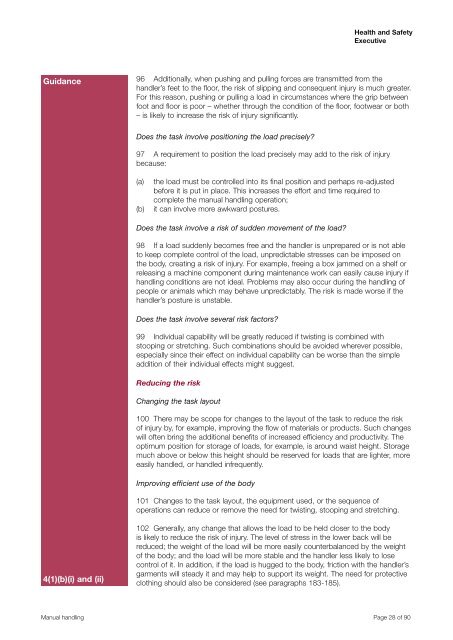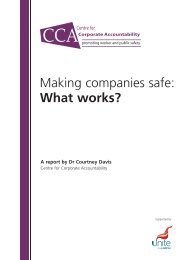Manual Handling Manual Handling Operations Regulations 1992 ...
Manual Handling Manual Handling Operations Regulations 1992 ...
Manual Handling Manual Handling Operations Regulations 1992 ...
Create successful ePaper yourself
Turn your PDF publications into a flip-book with our unique Google optimized e-Paper software.
Health and Safety<br />
Executive<br />
Guidance<br />
96 Additionally, when pushing and pulling forces are transmitted from the<br />
handler’s feet to the floor, the risk of slipping and consequent injury is much greater.<br />
For this reason, pushing or pulling a load in circumstances where the grip between<br />
foot and floor is poor – whether through the condition of the floor, footwear or both<br />
– is likely to increase the risk of injury significantly.<br />
Does the task involve positioning the load precisely?<br />
97 A requirement to position the load precisely may add to the risk of injury<br />
because:<br />
(a)<br />
(b)<br />
the load must be controlled into its final position and perhaps re-adjusted<br />
before it is put in place. This increases the effort and time required to<br />
complete the manual handling operation;<br />
it can involve more awkward postures.<br />
Does the task involve a risk of sudden movement of the load?<br />
98 If a load suddenly becomes free and the handler is unprepared or is not able<br />
to keep complete control of the load, unpredictable stresses can be imposed on<br />
the body, creating a risk of injury. For example, freeing a box jammed on a shelf or<br />
releasing a machine component during maintenance work can easily cause injury if<br />
handling conditions are not ideal. Problems may also occur during the handling of<br />
people or animals which may behave unpredictably. The risk is made worse if the<br />
handler’s posture is unstable.<br />
Does the task involve several risk factors?<br />
99 Individual capability will be greatly reduced if twisting is combined with<br />
stooping or stretching. Such combinations should be avoided wherever possible,<br />
especially since their effect on individual capability can be worse than the simple<br />
addition of their individual effects might suggest.<br />
Reducing the risk<br />
Changing the task layout<br />
100 There may be scope for changes to the layout of the task to reduce the risk<br />
of injury by, for example, improving the flow of materials or products. Such changes<br />
will often bring the additional benefits of increased efficiency and productivity. The<br />
optimum position for storage of loads, for example, is around waist height. Storage<br />
much above or below this height should be reserved for loads that are lighter, more<br />
easily handled, or handled infrequently.<br />
Improving efficient use of the body<br />
101 Changes to the task layout, the equipment used, or the sequence of<br />
operations can reduce or remove the need for twisting, stooping and stretching.<br />
4(1)(b)(i) and (ii)<br />
102 Generally, any change that allows the load to be held closer to the body<br />
is likely to reduce the risk of injury. The level of stress in the lower back will be<br />
reduced; the weight of the load will be more easily counterbalanced by the weight<br />
of the body; and the load will be more stable and the handler less likely to lose<br />
control of it. In addition, if the load is hugged to the body, friction with the handler’s<br />
garments will steady it and may help to support its weight. The need for protective<br />
clothing should also be considered (see paragraphs 183-185).<br />
<strong>Manual</strong> handling Page 28 of 90
















